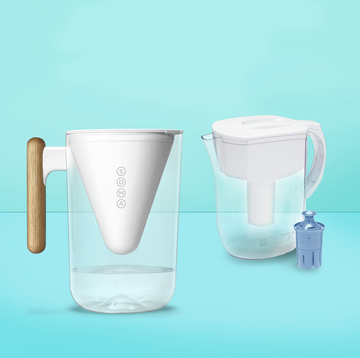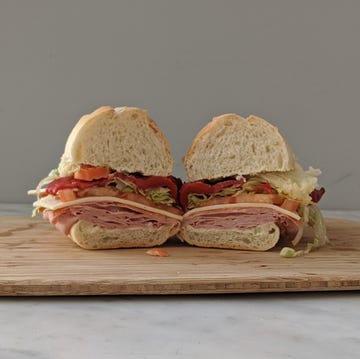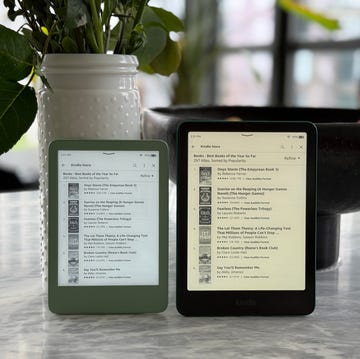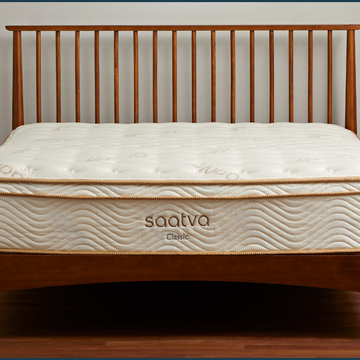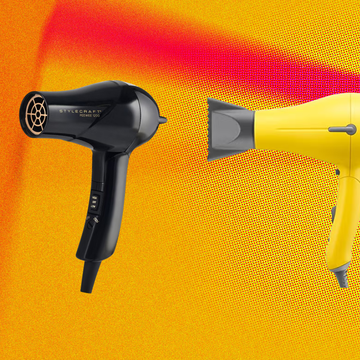There are as many reasons to filter your home's water as there are filtration methods. Here's why it matters:
- Tap water can harbor contaminants. Although public tap water must meet strict EPA standards, it can still contain germs (such as E. coli and norovirus), chemicals (including arsenic and PFAS, known as "forever chemicals") and other toxins, according to the Centers for Disease Control (CDC).
The chlorine used in water treatment can affect taste and odor. At elevated levels, it may cause skin irritation and other health issues. Even when water leaves treatment facilities perfectly clean, it can pick up lead, copper and other harmful metals from aging pipes en route to your home.
- Minerals, particularly calcium and magnesium, can create hard water. This can damage household plumbing and appliances over time while also affecting hair and skin health.
Fortunately, the U.S. water safety industry operates under strict regulations, ensuring that certified filtration systems deliver on their promises. The trick is identifying the right solution for your specific needs.
What are the types of water filters?
Most water filters use some kind of membrane to capture contaminants as water passes through it. Some catch more pollutants than others. Another differentiator is how automated the filtration process is versus doing things manually, like filling a carafe or toggling between filtered and unfiltered water at the tap.
Here’s an overview of the main categories:
Water filter pitchers
Average cost: $20 to $50
Also known as carafe-style filters, water filter pitchers are the least expensive way to filter drinking water, and many deliver excellent protection against a slew of contaminants. The downside is you need to fill the pitcher by hand, and the container takes up space in the refrigerator — or on the countertop if you like your water at room temperature. You also need to clean the pitchers regularly to prevent mold growth.
Pros
- Low upfront cost
- Replacement filters are inexpensive compared with other categories
- Many pitchers provided excellent filtration performance in our tests
Cons
- Pitchers need to be filled and cleaned by hand
- Take up space
Filtered water bottles
Average cost: $20 to $100
This is a newer category of filtration that makes it easy to enjoy filtered water on the go. It's a great way to save on the cost of bottled water while reducing your consumption of plastics. The inexpensive filtered water bottles can only hold so much liquid, and the smaller filters tend to be more limited in how much they can capture. Still, they’re a great way to stay hydrated with clean water throughout the day.
Pros
- Lightweight bottles are an easy way to bring filtered water to any part of the house
- Cheaper over time and better for the environment than plastic water bottles
Cons
- Less powerful filtration
- Limited volume of water
Countertop water filters
Average cost: $30 to $300
As you’ll guess from the name, countertop filters are designed to sit out on the countertop, though some models that come into our Lab for testing are svelte enough to live in the refrigerator. Like water pitchers, no installation is required, and the containers are often able to hold a lot of water, up to 30 cups in some cases. Filter times tend to be quite slow with countertop models, so it’s good to get into the habit of filling them the night before. To prevent mold and other grime, you also need to clean the containers by hand every week.
Pros
- Large capacities are a good fit for households that go through a lot of filtered water
- Many countertop models offer excellent filtration
- Relatively inexpensive
Cons
- Need to fill them manually and clean the container by hand
- Take up space on the countertop or in the fridge
Under-sink water filters
Average cost: $100 to $500
Our experts like under-sink filters for the combination of value, convenience and superb filtration. The devices consist of one or more filters that live in the cabinet under the sink and a dispenser that sits next to your main kitchen faucet. You might have to call in a pro for the installation, especially if a hole needs to be drilled in the sink deck. But the result will be a less-cluttered kitchen and water that is filtered with the turn of a handle.
Pros
- Robust filtering performance
- Streamlined, clutter-free design
- Long-lasting filters can go six months without replacing
Cons
- You might need to call in a plumber for the installation
- Cost of the initial system and replacement filters is on the higher side
Faucet-mount water filters
Average cost: $20 to $50
This is another cost-effective solution that delivers filtered water straight from the tap without the installation costs of an under-sink unit. A simple pull of a diverted valve switches the faucet from filtered to non-filtered water. The biggest downside with this option is it’s bulky, which might be an issue if you like a clean, streamlined look. Keep in mind as well that faucet-mount filters don’t work with faucets with a pull-down spray.
Pros
- Easy, inexpensive way to bring filtered water to the kitchen sink
- Does not require plumbing modifications or professional installation
Cons
- The bulky housings might be an eyesore in designer kitchens
- Not compatible with pull-down faucets
Refrigerator water filters
Average cost: $20 to $50
If your refrigerator has an ice and/or water dispenser, the water almost certainly runs through a built-in filter that needs to be replaced a couple of times a year. This is a very space-efficient way to bring filtered water into the home, though you have less control over which contaminants are removed from your drinking water since you need to use the same filter specified by the fridge manufacturer (third-party replacement filters can be found online, but they’re often cheap knockoffs).
Pros
- Convenient, space-efficient design
- The same filter works on ice and water
- Replacement filters are fairly inexpensive
Cons
- Filtration might not be as robust
- Need to be aware of cheap counterfeit replacement filters
Shower water filters
Average cost: $50 to $150
These filters are aimed at homes with hard water, which keeps shampoo from forming a nice lather, or chlorine-heavy water, which can be tough on the skin. Most shower filters attach to your existing showerhead, though we’re seeing more models that are a showerhead and filter in one, for a more streamlined look. Keep in mind that these filters are not subject to the same regulations as those that govern drinking water, so the claims are hard to prove.
Pros
- May improve hair and skin, especially if your home has very hard or heavily chlorinated water
- Easy to install and maintain
Cons
- Not regulated by industry standards
- Those that attach to existing showerheads are bulky
Whole-house water filters
Average cost: $1000 to $3500, installed
All the solutions listed so far are POU filters (short for “point of use”), meaning they capture contaminants from a single tap or fixture. Whole-house filters are POE (“point of entry”). They’re installed at the main water line, enabling them to treat all the water used throughout the home. Basic systems are designed to capture larger sediment, like sand and iron, which is tough on a home’s plumbing and appliances. Newer, more advanced whole-house filters can also remove lead, chlorine and chemicals, but these systems are pricey and require help from a professional.
Pros
- Treat all the water in the home at the point of entry
- Can extend the life of your home’s plumbing and appliances
- No modifications to existing fixtures are needed
Cons
- Systems require professional installation and maintenance
- Basic systems can’t capture as many contaminants as point-of-use filters
How can I check my water quality?
If your water comes from the town or city, the EPA requires local suppliers to provide an annual Consumer Confidence Report (CCR). The report will tell you which contaminants were detected in your water supply and any potential health effects.
It’s important to note that, even if your CCR report comes back clean, contaminants can still enter your water as they make their way from the treatment plant to your home. That’s especially true if your home was built before 1986 when lead-based plumbing was outlawed in homes.
A water test will provide the clearest picture of your home’s water quality. State-certified laboratories provide the most comprehensive testing, though our experts say DIY water test kits can be a cost-effective way to get a good sense of what contaminants may be lurking in your water.
More than 43 million Americans get their water from a private well, according to the U.S. Geological Survey. If you're among them, your water is not regulated in any way. So it’s critical to do an annual water test, since well water can be compromised by floods and other natural events, in addition to regular wear and tear.
How do I find the best water filter for my home?
The first step to finding the right water filter for your home is determining exactly what you need it to do. “If you are buying a system to improve taste or to address a particular contaminant, make sure the device is independently certified for that purpose,” said Greg Kail, Director of Communications at the American Water Works Association.
Here’s how to get there:
✔️ Check the certifications. Make sure any water treatment filter you buy lists any NSF/ANSI certification that it meets. This will tell you which contaminants the filter can remove, based on third-party testing. "The testing also looks at material safety, to make sure nothing can leach into the water, as well as structural integrity, hitting the filter with high-pressure spikes to make sure it won't leak, said Eric Yeggy, Director of Technical Affairs at the Water Quality Association.
Some of the most common NSF/ANSI certifications:
- NSF/ANSI 42: Verifies the reduction of aesthetic impurities such as chlorine and taste/odor.
- NSF/ANSI 53: Verifies the reduction of over 50 contaminants with potential health effects, including Cryptosporidium, VOCs and chromium.
- NSF/ANSI 177: Intended for shower filters, this standard only verifies the reduction of chlorine.
- NSF/ANSI 372: Verifies the reduction of lead to safe drinking levels.
- NSF/ANSI 401: Verifies the reduction of one or more of 15 emerging contaminants, including pharmaceuticals or chemicals not yet regulated by the EPA.
✔️ Know the type of filtration. While NSF/ANSI certification is key, it’s good to know what type of filter is used in a product since it can affect maintenance and durability. Here are the main options:
- Activated carbon: The most common option, these carbon-based filters act like a magnet, absorbing contaminants from the water. "Brands use proprietary additives to tweak the performance of carbon filters, allowing them to capture a wide range of contaminants," said Yeggy.
- Reverse osmosis (RO): This more aggressive type of filter captures contaminants by pushing pressurized water through a semi-permeable membrane. While extremely effective, it's more expensive and can be less space-efficient — many systems require a tank that won't fit under your sink.
- Ultraviolet (UV): This chemical-free disinfection method has been in commercial use for decades, and it's now coming into more homes. UV systems kill bacteria, viruses and other microbes by exposing them to light at just the right wavelength. It's a common treatment for private well water, which is vulnerable to these kinds of contaminants.
- Ion exchange: Common on whole-house systems, ion exchangers use sulfonated, polystyrene beads to remove hardness ions from water and replace them with softer ions, often sodium. They can be paired with a separate filtration system that removes organic and inorganic materials.
✔️ Think about installation and maintenance. These factors will impact the time, effort and expense you’ll need to pour into your water filter solution.
- Water filter pitchers and countertop filters don’t require any installation and maintenance consists solely of changing the filter and washing the container.
- Faucet-mount filters are also DIY-friendly and low-maintenance.
- Under-sink filters may require professional installation, though experienced DIYers can probably handle the installation and filter replacements.
- Whole-house water filtration systems require professional installation, with an average cost of around $2,300, according to ANGI, the home services marketplace, plus another few hundred dollars per year in maintenance calls. The Water Quality Association has an online database of certified professionals who can help you figure out the right system, and then handle the installation and ongoing maintenance.
Why trust Good Housekeeping?
Our team of home and health experts at the Good Housekeeping Institute is constantly testing water filtration products, both in our Lab and in the homes of expert testers. Dan DiClerico has written about the residential water filter market for 25 years, reviewing dozens of products and systems from all leading brands. In his role as Director of the Home Improvement & Outdoor Lab at the Good Housekeeping Institute, Dan oversees water filter testing alongside our health and technical experts.
We also consult with outside organizations, including experts from NSF International, the organization that develops public health standards and certification programs for the industry, and the Water Quality Association (WQA), a not-for-profit trade group representing the U.S. water treatment industry.
Having written thousands of product reviews and how-to articles on all aspects of home ownership, from routine maintenance to major renovations, Dan (he/him) brings more than 20 years of industry experience to his role as the director of the Home Improvement & Outdoor Lab at the Good Housekeeping Institute. A one-time roofer and a serial remodeler, Dan can often be found keeping house at his restored Brooklyn brownstone, where he lives with his wife and kids.











